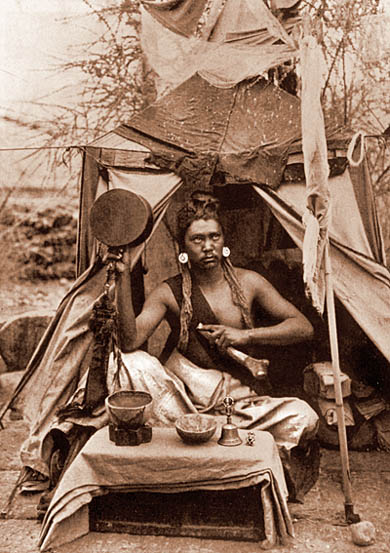The current (December 2015) issue of Revue d’Etudes Tibétaines is a special collection on Women as Visionaries, Healers and Agents of Social Transformation in the Himalayas, Tibet and Mongolia.
This post draws on “Empowering Religious Women Practitioners in Contemporary Bhutan,” an article in it by Françoise Pommaret. She describes many ways the social status and religious opportunities of Bhutanese women have improved dramatically over the past decade or two, under the influence of modern egalitarian ideas. Some of these came directly from ethnically Western Tibetan Buddhist women practitioners, notably Venerable Karma Lekshe Tsomo.
Most relevant here is a discussion of a new social context for Tröma Nakmo practice. Tröma Nakmo is now practiced by thousands of laywomen, ngakmas, and nuns in Bhutan, in a distinctively modern format. Although Tröma and chöd have always been connected with women in theory, in recent centuries very few women have been permitted to do any sort of formal tantric practice. Lay people have also mainly been excluded; ngakpas have faced organized oppression; and ngakmas have been so rare that many Tibetans and Bhutanese had never heard of them, and denied that there is such a thing.
The new approach to Tröma Nakmo was introduced by Dungse Garab Dorje Rinpoche, son of Thinley Norbu Rinpoche, who was the eldest son of Dudjom Rinpoche. Dudjom Rinpoche was the foremost Nyingma lama of the past century, terton of the Dudjom Tersar, and a ngakpa. Thinley Norbu Rinpoche was born in Bhutan and lived there as a young man, but moved permanently to America in the mid–1970s. He wrote many excellent books in his own English. He was considered the holder of the Dudjom lineage after his father’s death.
Pommaret writes that Garab Rinpoche now leads 25 local Tröma Nakmo associations in Bhutan, each with 500 to over 1000 members. Practitioners assemble several times a month in small groups to perform the two-hour ritual. In urban centers, they meet in private houses after office hours.
There are both mixed-sex and women-only groups.
Women make up the majority of the Black Throema [Tröma Nakmo] followers. They have a great devotion for the female Black Throema practice corresponding with the female form of this ḍākinī. This practice allows ordinary women to engage in a religious activity that empowers them as women in ways that go well beyond the spinning of prayer wheels. As members of these groups, they are acknowledged as having the same degree of awareness and socio-religious status as men, a novelty in Bhutanese monastic society.
Garab Rinpoche also leads large-scale drupchen/tsok rituals several times a year. The video at the top of this page shows one at Bodhgaya, in India. It is interesting for the diversity of participants. Sam Bercholz wrote of Thinley Norbu Rinpoche:
His American community was an interesting mixture of males and females of all ages and almost equally made up of Tibetan/Bhutanese, Chinese, and Westerners—all practicing as one harmonious group.
In the Bodhgaya video, you can see ngakpas, ngakmas, lay people, monks and nuns practicing equally; and there are white and Chinese people, some in full gökar changlo, scattered among the Himalayans, on an apparently equal basis.
Here is a video of a large encampment (gar) in Paro, Bhutan, last year:
Striking here are the chöd tents, which are traditional, but whose use had almost entirely died out. I’ve only come across them in historical photographs.

At this event, there are very few monastics. Some of the participants are ngakpas and ngakmas (with full gökar changlo, conch earrings, and so forth). Most are lay people. Lay disciples of Garab Rinpoche generally wear a maroon shamthab, a white shirt, and a ngakpa-style zen. (I would be interested to know whether this is viewed as a step on a path toward full ngak’phang ordination.) You can also see many in the crowd wearing Western-style street clothes, but with a gomtag.
I went on pilgrimage in Bhutan in 2003. The country was changing rapidly. Cable TV was introduced in 2000, and by 2003, most people in the towns had forty-something channels of shiny American and Indian consumer culture pumped into their living rooms. The internet and mobile phones had just arrived. Suddenly, urban Bhutanese were part of the atomized global consumer monoculture. Talking with lay people, it was clear that the traditional Buddhism they’d grown up with had no answers for the spiritual problems of modernity. I wrote to my lamas:
Children growing up today will, I think, outgrow their parents’ belief in the concrete reality of ghosts and demons as they outgrow the Scooby-Doo cartoons they now watch on TV. As birth rates fall, there won’t be enough new monks to fill the temples. As democratic ideas infiltrate, there will be popular support for emancipation of the existing monks. Perhaps many Bhutanese will convert to Christianity and Hinduism, the religions of the imported cultures. All will prostrate before the universal god Shopping.
But perhaps there will be a window, an opening, a decade or two in which devotion to the brand-name ‘Buddhism’ persists, in which people still remember the Bhutan that was lost, in which some start to wonder why owning the right brand of vacuum cleaner does not make them happy. And as the level of education rises, there may be a hunger for a more sophisticated religion than the karmayana of their parents… a religion such as, perhaps, …
Buddhism.
That I hope for with all my heart.
I hoped Bhutan could develop a modern Vajrayana, which would address the spiritual needs of educated urban lay-people—but it seemed an impossible fantasy. The power of the traditional monastic theocracy was too great, as was the power of modern nihilistic consumerism; between them, there could be no room for a functional Vajrayana Buddhism.
I was repeatedly astonished by the resourcefulness and common sense of the Bhutanese, as individuals and as a society. It seems I still underestimated them. Innovative modern Vajrayana—emphasizing ngak’phang and lay practice—is flourishing.
